Vetiver – Vetiveria zizanioides Uses, Research, Side Effects
Ushira – Vetiver is a coolant, but yet aids in digestion. It is widely used in treating fever, dysuria, burning sensation, fatigue syndrome, skin disorders etc. Potable water prepared with this also has many health benefits.
Botanical Name – Vetiveria zizanioides (Linn) Nash.
Synonyms: Andropogon muricatus Retz. Andropogon squarrrosus Hook. F. Non Linn. F, Chrysopogon zizanioides
Family- GRAMINAE (Yava Kula)
Table of Contents
Vernacular names
Names in different languages:
Hindi Name- Khas, Usheer
English name – khas khas grass, Kus Kus grass, Vetiver
Kannada name – Lavancha
Telugu name – Vattivellu
Bengali name – Khaskhas, Venaghas
Marathi name – Vala
Gujarati name – Valo
Tamil name – Vettiver, Vetivera
Malayalam name – ramacham
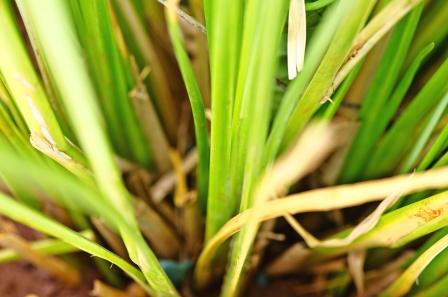
Uses
Use of Usheera (Vetiver) in Fever:
Usheer is widely used for the treatment of fever of recent origin. (Taruna Jwara).
It helps to relieve Ama (A product of weak digestion and metabolism). It does Ama Pachana.
Being a coolant, it relieves burning sensation and controls body temperature.
It helps to relieve Ama from Rasa (nutrient fluid after digestion) and Rakta (blood tissue).
Vetiver uses:
Pachana – Digestive, relieves Ama Dosha
Stambhana – blocks, dries up channels
Dahahara – Relieves burning sensation, as in gastritis, neuropathy, burning sensation in eyes etc
Madahara – relieves intoxication
Jwarahara – useful in fever
Trushnahara – Relieves thirst
Asrajit – useful in blood disorders such as abscess
Vishahara – Anti toxic
Daurgandhyahara – relieves bad odor
Mutrakrichrahara – Relieves dysuria, urinary retention, acts as diuretic
Kushtanut – useful in skin diseases
Vaminut – relieves vomiting
Vranahara – heals wounds quickly
Klantihara – relieves tiredness, fatigue
Vataghna – useful in treating disorders of Vata Dosha imbalance such as neuralgia, paralysis, constipation, bloating, etc
Mehanut – useful in urinary tract disorders and diabetes
For excessive sweating, thirst
How to use usheerasava for excessive sweating and thirst?
1 tablespoon is mixed with 5 cups of water. Boiled for 2 minutes. Filtered. This is consumed in place of water, throughout the day. Everyday, it needs to be prepared fresh.
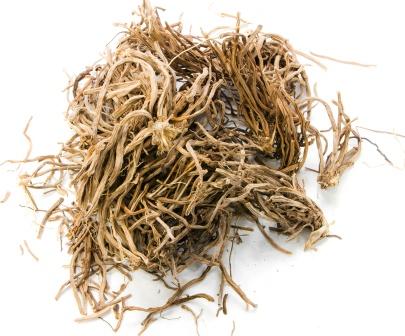
Classical categorization
Charaka-
Varnya – Group of herbs useful in improving complexion
Stanyajanana – Group of herbs promoting lactation
Chardinigrahana – Antiemetic group of herbs
Daha Prasamana – Burning sensation relieving group of herbs
Angamardaprasamana – Bodyache relieving group of herbs
Shukrasodhana – Semen, sperm cleansing and quality improving group of herbs
Tikta Skandha – Bitter tasting group of herbs
Sushruta-
Sarivadi, Eladi Gana
Pittasamsamana – Pitta pacifying group of herbs
Vagbhata- Sarivadi
Bh Pr . Ni – Karpooradi varga
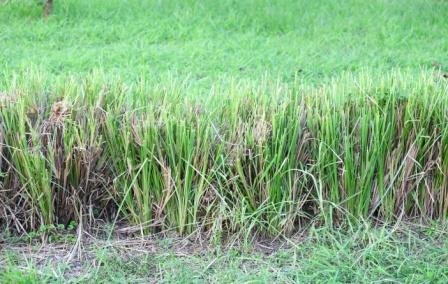
Distribution
Usheer is found in aquatic and subaquatic places across India, Dakshina bharata, Bengal, Rajasthan especially in the river banks
Morphology
Habit- A densely tufted perennial grass. Root stock branching with spongy aromatic roots
Leaf sheaths compressed, especially the lower sheaths which are sharply keeled, fan-like, very smooth and firm
Inflorescence-Raceme, upto 5 cm long, very slender rough, minutely and unequally cililate, pedicels similar. yellowish or violet brown or purplish in colour.
Useful part- Root
Roots are fibrous, wiry, up to 2 mm in diameter, longitudinally grooved, cream, gray or light yellow to brown in colour. Has a very strong aromatic odor. Taste is slightly bitter.
Chemical constituents
Vetiveria zizanioides chemical constituents
Allokhusiol, Benzoic acid, Cyclocapacamphene, Epikhusinol, epizizanal, 2- epizizanone, B- eduesmol, Eugenol, Iskhusimol, Isokhusinoloxide, Isovalencenol, Isovalencic, Khusimyl acetate, Khusinodiol, Khusinol, Khusitoneol, Laevojujenol, Levojunenol, Vanillin, Vertiselinenol, B-& J vetivene, Vetivenic acid, vetiverol, Zizaene, Zizanol etc.
(Reference: Illustrated Dravyaguna VIjnana, Vol. II, by Dr JLN Shastry)
Types
There are many ecotypes of vetiver. The vetiver called VS-01 (or Sunshine) is a South Indian variety, has robust root system, and has 1% aromatic oils in its roots. Other varieties like VS-03 have less aromatic oil content (around 0.3%). Research has shown that the aromatic oil is produced in the roots by certain bacteria from precursors released by the vetiver. Just to say that all vetiver roots are not the same.
Usheer roots treat the mother earth too. Maybe it is mentioned in Krishi Shastra. Vetiver roots increase the ground water recharge capability of soils. It increases the biomass content in the soil up to 3 meters depth. It will be very difficult to add leaves and manure at that depth. Vetiver roots add the biomass as roots, and they decay after 18 months . Vetiver root oil is termite-repelling. The vetiver root system increases the aeration in the soil, and prevents nematode (small worms that attack the roots and other plants) infection. Because of these effects, vetiver grown as rows along vegetable farms, and around trees in orchard have improved the health and yield of the cultivated crops. Thus growing neem, tulasi and vetiver in farms and around houses is good for the health of the plants and animals in the earth. (Contributed by Mr Vinod Kumar).
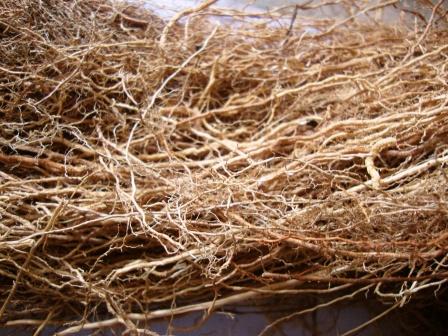
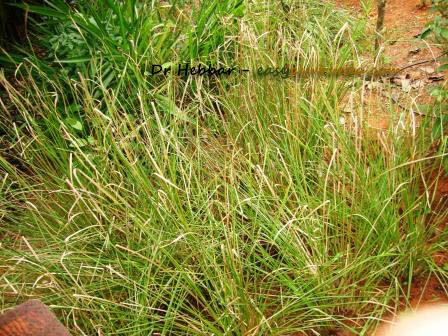
Medicinal properties
Vetiver medicinal properties:
Rasa (taste) – Tikta (bitter), Madhura (sweet)
Guna (qualities) – Rooksha (dryness), Laghu (lightness)
Vipaka- Katu – Undergoes pungent taste conversion after digestion
Veerya – Sheeta – Cold potency
Effect on Tridosha: Pacifies Vata and Pitta
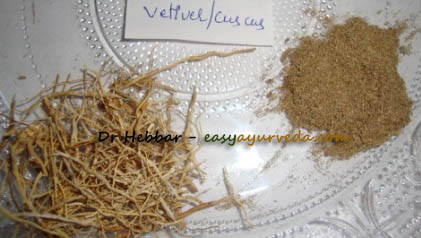
Part used, dosage
Part Used: Usheer Root, Vetiver Oil
Dosage: Powder 3-6g; decoction 50-100ml; infusion (Hima / Phanta) – 25-50ml
How to take Usheera?
Its water, as explained above, can be used as potable water.
Its powder or water decoction is also used in medicine. It is administered along with cow ghee, honey etc based on disease.
Its powder paste is applied externally.
Vetiver Home remedy for gastritis and heartburn
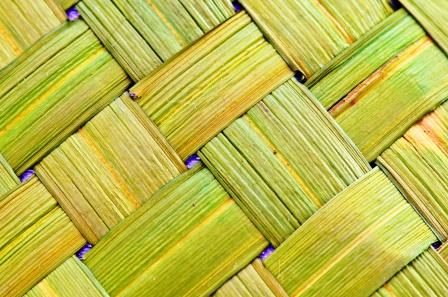
Sanskrit verse
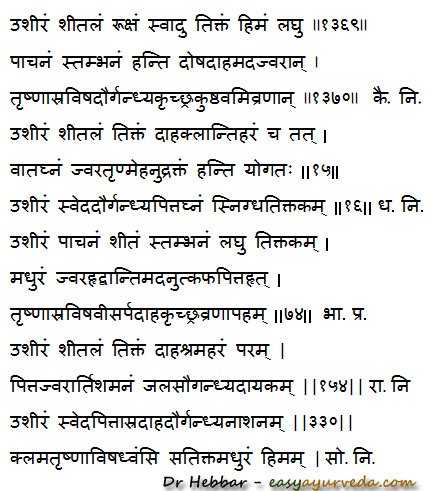
Vetiver water
Vetiver is used to make potable water. A few grams of Vetiver root powder is added to water and this water is filtered and used after 2 – 3 hours. Once the vetiver is put into water, the water should be used within 10 – 12 hours of time. Each day, water and vetiver should be replaced with fresh ones.
Such prepared water will have almost all the qualities of Usheera, as explained above, but in slightly lesser intensities.
External application
To apply externally as paste, to relieve burning sensation, skin disorders and to relieve excessive sweating, there is nothing better than Usheera. Reference: Charaka Sutrasthana 25
Its root powder is made into paste and applied to relieve burning sensation, burn wounds, to relieve excessive sweating, in skin disorders and to improve skin complexion.
Interaction with medicines, supplements
Can this be used while taking Homeopathic medicine?
Yes. This product does not react with homeopathic medicine.
Can this medicine be continued while taking supplements like multivitamin tablets, Omega 3 fatty acids etc?
Yes. Generally, this product goes well with most dietary supplements. However, if you are taking more than one product per day, please consult your doctor for an opinion.
With western
medicines
Seek your
doctor’s advice if you are taking this product along with other western
(allopathic / modern) medicines. Some Ayurvedic herbs can interact with modern
medicine.
If both Ayurvedic and allopathic medicines are advised together, then it is
best to take Allopathic medicine first, wait for 30 minutes and then take the
Ayurvedic medicine.
Vetiver oil uses:
Vetiver oil is used for external application in rheumatism, sprains and arthritis.
Research
Antioxidant potential
Anti-tuberculosis activity
Ayurveda medicines
Ayurveda medicines with Usheera as ingredient:
Usheerasava – a fermented medicine used in skin diseases, intestinal worms, bleeding disorders etc
Shadanga Paniya – An herbal drink used to treat fever
Gopanganadi Kashayam – used in the treatment of Pitta type of fever.
Nisosiradi Oil – an effective Ayurveda herbal oil used to treat diabetes, carbuncles and abscesses.
Vetiver essential oil: Is used as ingredient in many Ayurvedic medicines such as Borototal cream
Sanskrit synonyms
Nalada – It has pleasant aroma
Jalavasa – Grows commonly near water resources
Amrnala, Veerana, Virani, Veeratara, Valaka, Balaka, Truna Valukam, Veniga Mulakam
Abhaya, Ranapriya, Virataru, Haripriya,
Jalavasa, Jalaamoda – Grows in moist places
Amrunala, Mrunalaka – Appears similar to lotus stalk
Sugandhika, Samagandhika, Sugandhamula – Has a pleasant odor
Bahumoola – bushy root
Shishiram, Sheetamoola – root is a coolant
Sevya – Suitable for consumption
Sthanika Karma (Systemic Action)
External Application – External application of its paste is indicated in skin diseases, reduce burning sensation, excess sweating
Internal administration –
Nervous System – Strengthens the brain and nervous system. Indicated in, giddiness and diseases of pitta origin.
Digestive System – Being tikta (bitter) in taste acts as carminative and digestive. Because of its cold potency it is good for relieving thirst and vomiting. Indicated in loss of appetite, low digestive fire, indigestion, vomiting, diarrhea.
Circulatory System – Because of its bitter taste (tikta) it helps to purify blood. Its cold potency helps to promote body strength, calms the mind. Indicated in bleeding disorders, weakness of heart.
Excretory System – it has diuretic action as it is cold in potency. Indicated in Dysuria (mutra krichra)
Satmikarana – Anti poisonous, indicated in general debility, body weakness
Tvak (Skin) – Indicated in skin diseases, over sweating conditions (bad body odor)
Tapakrama – Indicated in fever with burning sensation.











15 comments
sri
sir, can we take Vetiver water on regular basis in summer for three months? but it was identified for promoting lactation. so if we take it on regular basis will it increases prolactin? iam pitta person basically . thts why iam asking
Dr J V Hebbar MD(Ayu)Author
Hi, if a person already has hyperprolactinemia, in such a person it is best to avoid vetiver water. But for a normal person, taking vetiver water on regular basis in summer for three months is good. Read more about summer regimen here – https://www.easyayurveda.com/2014/09/13/ayurvedic-health-tips-for-summer-season/
Dr J V Hebbar MD(Ayu)Author
Assuming that it is very diluted, a few drops can be given.
Raga
How does the vetrivel watet taken help cancer patients taking chemo
Dr J V Hebbar MD(Ayu)Author
It helps to reduce Pitta, it relieves burning sensation, heals skin wounds / ulcers quickly.
Shanthi
Sir, I wanted to mix vattivellu paste(58gms) as one of the ingredient of preparing hair oil for growing hair on baldness..is it advisable to use?
Gurunandan hebbar
I don’t replace the roots for a month. Once I put the root I keep refilling my pot and drinking the water over a month. Is this ok?
Dr J V Hebbar MD(Ayu)Author
It is best to replace the root at least once in 2 days.
Sindhu Raju
Hi, can vetiver water be used on a regular basis to drink for a person suffering from ulcerative colitis.
Sunil
How we cultivate wala
Dr J V Hebbar MD(Ayu)Author
More details here
https://dmapr.icar.gov.in/Publications/Bulletine/Vetiver%2016-1-15.pdf
Shridev gowda
Sir can we use ushira in preparation of baby oil
Dr J V Hebbar MD(Ayu)Author
Yes. It is mild and adds its own aroma.
Samiksha Jain
Can vetiver water be had during winters as well? I have fibromyalgia.
Dr J V Hebbar MD(Ayu)Author
Yes.